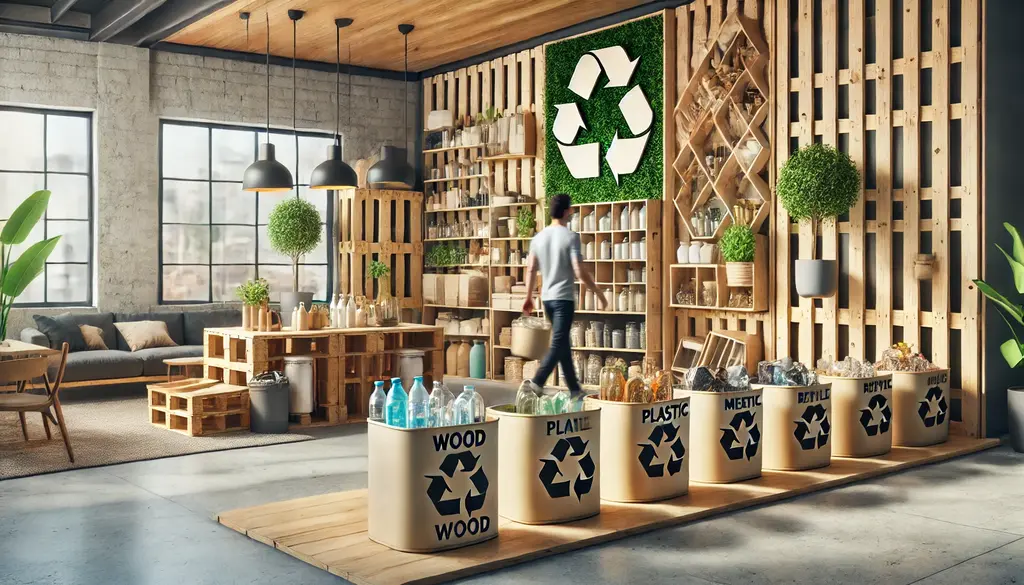Any home improvement project, big or small, creates waste. Handling this waste responsibly is becoming increasingly important. Fortunately, smart recycling provides a practical way to reduce the environmental footprint of renovations, conserve valuable resources, and sometimes even lower disposal costs.
Effective recycling is an eco-friendly choice and part of modern, responsible home improvement. Consider these essential strategies for integrating recycling smoothly into project work.
Why Focus on Recycling During Renovations?
The excitement of a fresh look can overshadow the less glamorous side: the debris generated. Construction and demolition activities contribute significantly to landfill volumes. Common materials like wood, metal, concrete, and drywall often end up buried, despite having the potential for a second life.
Recycling these materials accomplishes several key things. It keeps usable resources out of landfills, thereby reducing the demand for new raw materials such as timber, ores, and aggregates. Manufacturing products from recycled content typically uses less energy than starting from scratch.
Additionally, many areas now have regulations that encourage or require the diversion of construction waste from landfills.
Strategy 1: Dismantle Smartly, Sort Immediately
Successful recycling starts with how things are taken apart. Moving away from brute-force demolition towards careful deconstruction makes a world of difference.
The Value of Deconstruction
Instead of simply smashing and clearing, deconstruction involves taking structures apart piece by piece. The goal is to salvage items that can be reused and separate different materials cleanly for recycling.
Carefully consider removing kitchen cabinets, doors, usable windows, or light fixtures. These items, kept intact, might be perfect for donation or resale, diverting them from the waste stream entirely. This careful approach takes planning but maximizes material recovery.
On-Site Sorting is Key
As materials are received, sorting them immediately prevents contamination and simplifies the recycling process down the line.
Set up distinct areas or use clearly labeled bins for different categories, such as clean wood, metals, concrete and brick, cardboard, and drywall. Keeping these streams pure is vital.
A load of wood mixed with plastic wrap and insulation is likely to be rejected by a wood recycler and end up costing more to dispose of as general waste.
Training the crew or maintaining discipline on a personal project ensures materials go to the right place from the start.
Strategy 2: Tackle the Big Waste Generators
Focusing recycling efforts on the most common and bulky materials generated during renovations yields the most significant environmental benefit.
Metals: Always Worth Recycling
Metals are consistently valuable recyclables.
- Steel and Iron: These are commonly found in studs, pipes, old appliances, and ductwork. Recycling steel saves a significant amount of energy compared to primary production.
- Copper, Aluminum, Brass: Wiring, plumbing pipes, gutters, window frames, and specific fixtures contain these valuable non-ferrous metals. Keep them separate from steel, as they command higher prices at scrap yards.
Managing Wood Debris
Wood often constitutes a significant portion of renovation waste.
- Clean Wood: Unpainted, untreated lumber and panels (such as plywood and OSB) can typically be chipped for landscape mulch, used in compost, or potentially burned as a biomass fuel.
- Problem Wood: Wood treated with chemicals (such as old deck boards) or coated with lead paint requires careful handling, often necessitating disposal according to local hazardous waste regulations, rather than standard recycling.
Concrete and Masonry
Broken concrete, bricks, and blocks are heavy but highly recyclable. Crushed concrete or brick becomes recycled aggregate, a valuable material for road bases, fill, or even new concrete mixes.
Specialized C&D recycling centers accept these materials, often requiring them to be relatively clean of contaminants, such as excessive wood or plastic.
Cardboard Packaging
Don’t overlook the mountain of cardboard boxes from new materials and fixtures. Flatten boxes and keep them dry for efficient recycling. Include clean paper waste in this stream.
Strategy 3: Handle Specialized Materials Correctly
Some common renovation materials require specific recycling pathways, not just the general construction and demolition (C&D) facility.
Drywall (Gypsum Board)
Drywall recycling requires dedicated facilities. These centers grind the board, separate the paper, and recover the gypsum powder for reuse in new drywall or as a soil conditioner—key point:
Drywall must be kept clean and dry at all times. While painted drywall is often fine, material contaminated with mold, lead paint, or insulation is usually rejected.
Asphalt Roofing Shingles
Old shingles can often be recycled into asphalt pavement mixes or road patching compounds. Shingle recycling facilities usually require the shingles to be free from other roofing debris.
Check with local paving companies or prominent construction and demolition (C&D) recyclers about available programs.
Construction Plastics
Plastics like PVC pipes, vinyl siding, plastic sheeting, and foam insulation are tricky. Rigid plastics, such as PVC and vinyl, are sometimes accepted by specialized recyclers if they are sorted and clean.
Plastic films and foam are rarely accepted in standard recycling and must be dropped off at dedicated locations, if available. Reducing their use or finding alternatives is often a more practical, sustainable strategy.
Household Hazardous Waste (HHW)
Renovations often involve leftover paints, solvents, adhesives, caulks, old pesticides, or fluorescent bulbs. These items are hazardous and require special disposal. Never put them in the regular trash or recycling bin.
Use designated HHW collection events or permanent drop-off sites provided by the local waste authority to ensure safe handling.
Strategy 4: Reuse and Repurpose Before Recycling
Recycling is beneficial, but reusing items directly is even more effective, as it saves the energy required for reprocessing.
Give Items a Second Life
Look for opportunities to salvage materials in usable condition:
- Functional cabinets, doors, windows, light fixtures, sinks, and toilets can often be donated to non-profit building supply stores (like Habitat ReStores) or sold online.
- Unique architectural elements might be of interest to salvage yards.
- Even small hardware like hinges and knobs can be saved or donated.
Creative Repurposing On-Site
Consider ways to use the removed materials elsewhere on the property:
- Untreated lumber scraps can be repurposed into workshop shelves or garden stakes.
- Broken concrete chunks, known as urbanite, can form pathways or retaining walls.
Strategy 5: Plan Your Waste Strategy in Advance
Achieving reasonable recycling rates requires careful planning before the project commences.
Pre-Project Groundwork
- Estimate Waste: Anticipate the primary types and quantities of debris the project is likely to generate.
- Find Local Outlets: Research nearby C&D recycling centers, scrap yards, donation centers, and household hazardous waste (HHW) facilities. Confirm what they accept, their hours, and any fees. Knowing the options informs the sorting plan.
- Outline the Process: Decide how materials will be sorted, stored temporarily on-site, and transported. If working with a team, communicate the plan.
Smooth Execution
- Use Proper Bins: Rent separate, clearly labeled containers if space and volume permit. For smaller jobs, designate distinct, marked areas for sorted piles.
- Maintain Sorting Discipline: Regularly check that materials are going into the correct streams. Contamination can derail recycling efforts quickly.
A solid waste management plan, integrated from the start, makes recycling a routine part of the workflow, not an afterthought. Projects planned this way consistently achieve better waste diversion results.
Conclusion
By consciously applying these strategies, home improvement projects can become significantly more sustainable. Viewing renovation waste as a potential resource rather than just trash conserves natural materials, reduces landfill burdens, and reflects a commitment to responsible practices.
The effort pays off in creating spaces that are not only aesthetically improved but also grounded in environmentally sound choices.
Stay tuned with HomesHelp for more content like this!
FAQs
What’s the main difference between reusing and recycling materials during a renovation?
Reuse means using an item again in its current form, possibly for a new purpose, without breaking it down first (e.g., donating old cabinets). Recycling involves processing waste materials, such as crushing concrete or melting metal, to create new raw materials for manufacturing. Reuse generally saves more energy and resources.
How do I find facilities that accept construction and demolition (C&D) waste for recycling?
Check your local city or county waste management authority’s website for the most up-to-date information. They usually list licensed C&D recyclers and related facilities. Searching online for “C&D recycling near me” or specific materials, such as “concrete recycling [your city],” is also effective. Always call ahead to confirm accepted materials and procedures.
Can all wood from a renovation project be recycled?
Not necessarily. Clean, untreated wood is often recyclable into mulch or other products. However, wood treated with preservatives or contaminated with lead paint typically requires special disposal and is not suitable for standard wood recycling programs. Keep clean and contaminated wood separate.
Where should leftover paint, solvents, or old chemicals from a project be disposed of?
These are considered Household Hazardous Waste (HHW). They cannot go in regular trash or recycling. Find out about your local HHW collection program through your city or county waste services – they will direct you to specific drop-off events or permanent facilities for safe disposal.
Are old kitchen appliances, such as refrigerators and ovens, recyclable?
Yes, major appliances are primarily made of metal and are highly recyclable. Scrap metal dealers usually accept them. Sometimes, the retailer delivering a new appliance will take the old one. Note that appliances containing refrigerants require professional refrigerant removal before scrapping, which may incur a fee.




